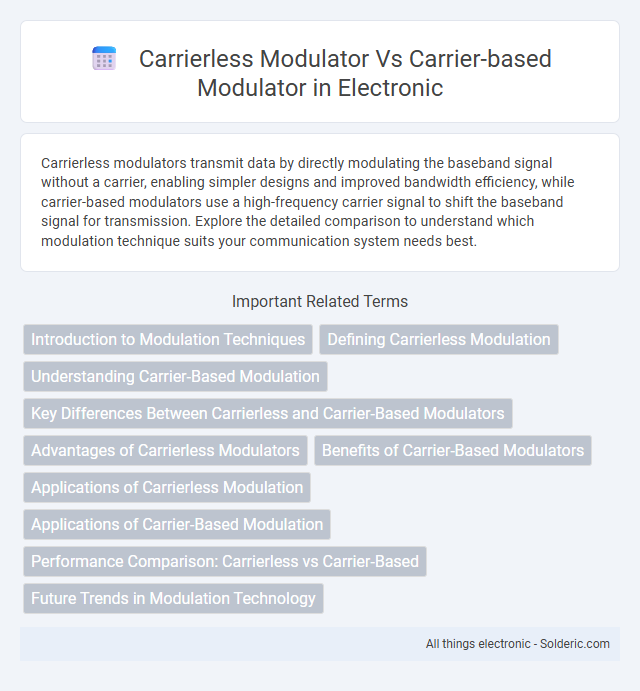Carrierless modulators transmit data by directly modulating the baseband signal without a carrier, enabling simpler designs and improved bandwidth efficiency, while carrier-based modulators use a high-frequency carrier signal to shift the baseband signal for transmission. Explore the detailed comparison to understand which modulation technique suits your communication system needs best.
Comparison Table
| Feature | Carrierless Modulator | Carrier-Based Modulator |
|---|---|---|
| Carrier Signal | No carrier signal used | Uses a continuous carrier frequency |
| Bandwidth Efficiency | Higher, due to no carrier transmission | Lower, bandwidth consumed by carrier |
| Power Efficiency | More power efficient | Less power efficient due to carrier energy |
| Complexity | Higher modulation/demodulation complexity | Lower complexity, simpler circuitry |
| Interference Susceptibility | Less interference from carrier noise | Potential interference from carrier signal |
| Typical Applications | Data communication systems, digital signals | Analog communication, AM/FM radio, broadcasting |
Introduction to Modulation Techniques
Carrierless modulators transmit signals by encoding information directly onto the amplitude or phase without using a separate carrier frequency, enhancing spectral efficiency and reducing power consumption compared to carrier-based modulators that rely on a continuous carrier wave for signal transmission. Carrier-based modulation techniques, such as AM, FM, and PM, typically involve mixing data with a sinusoidal carrier to shift the signal spectrum, which can be beneficial for long-distance communication but may introduce bandwidth inefficiencies. Carrierless modulation methods, including baseband modulation schemes like PAM, QAM, and OFDM, offer improved signal quality and bandwidth utilization, making them suitable for modern high-speed digital communication systems.
Defining Carrierless Modulation
Carrierless modulation transmits data without a continuous carrier wave by directly encoding information onto baseband signals, reducing spectral inefficiency and minimizing power consumption. Unlike traditional carrier-based modulators that rely on a fixed frequency carrier to modulate amplitude, frequency, or phase, carrierless techniques use pulse shaping and signal processing to generate modulated waveforms. This approach enhances bandwidth efficiency and mitigates interference, making it ideal for advanced communication systems such as ultra-wideband (UWB) and spread spectrum technologies.
Understanding Carrier-Based Modulation
Carrier-based modulation involves combining the information signal with a carrier wave of specific frequency and amplitude, enabling efficient transmission through various communication channels. Common types include Amplitude Modulation (AM), Frequency Modulation (FM), and Phase Modulation (PM), each varying the carrier's attribute to encode data. This technique ensures better signal integrity and synchronization, essential for conventional radio frequency communication systems.
Key Differences Between Carrierless and Carrier-Based Modulators
Carrierless modulators transmit information by directly encoding data onto a baseband signal without using a separate carrier frequency, resulting in reduced bandwidth consumption and improved spectral efficiency. Carrier-based modulators rely on a high-frequency carrier wave to shift the signal's frequency spectrum, enabling easier signal separation but often requiring more power and bandwidth. The absence of carrier signals in carrierless modulators decreases hardware complexity and enhances power efficiency, making them suitable for applications demanding compact and energy-efficient designs.
Advantages of Carrierless Modulators
Carrierless modulators eliminate the need for a separate carrier signal, reducing power consumption and improving spectral efficiency in communication systems. They offer better bandwidth utilization, minimizing interference and enhancing signal quality for your data transmission. This leads to simpler transmitter design and increased robustness in scenarios with carrier frequency instability or Doppler shifts.
Benefits of Carrier-Based Modulators
Carrier-based modulators offer precise control over the carrier frequency, resulting in improved signal stability and reduced phase noise essential for high-quality communication systems. They enable straightforward demodulation techniques, which simplify receiver design and enhance overall system efficiency. The inherent robustness of carrier-based modulation against interference and multipath fading makes it a preferred choice in long-distance and high-frequency applications.
Applications of Carrierless Modulation
Carrierless modulation is extensively applied in optical communication systems, enabling higher spectral efficiency and reduced interference compared to carrier-based modulators. It is ideal for high-speed data transmission in fiber-optic networks, advanced digital communication systems, and microwave photonics, where minimizing carrier-related distortions enhances signal quality. These modulators support emerging technologies such as 5G, data centers, and coherent optical communication by facilitating complex modulation formats without the need for a continuous carrier wave.
Applications of Carrier-Based Modulation
Carrier-based modulation is widely used in traditional communication systems such as AM, FM, and Phase modulation for radio broadcasting, satellite communication, and cellular networks. These modulators provide stable carrier signals that facilitate efficient demodulation and signal recovery in noisy environments, making them suitable for long-distance communication and high-speed data transmission. Your choice of carrier-based modulation can enhance performance in applications requiring robust and consistent signal integrity.
Performance Comparison: Carrierless vs Carrier-Based
Carrierless modulators eliminate the need for a continuous carrier signal, resulting in improved spectral efficiency and reduced power consumption compared to carrier-based modulators, which rely on a stable carrier waveform. Carrier-based modulators typically offer better noise immunity and simpler demodulation due to the presence of a reference carrier but suffer from bandwidth inefficiency. Performance metrics such as bit error rate (BER) and signal-to-noise ratio (SNR) favor carrierless modulators in high-bandwidth scenarios, while carrier-based systems maintain advantages in stable, narrowband communication environments.
Future Trends in Modulation Technology
Carrierless modulators are increasingly favored in future modulation technology for their improved spectral efficiency and reduced power consumption compared to traditional carrier-based modulators. Advances in software-defined radio and digital signal processing enable carrierless designs to support higher data rates and adaptive modulation schemes, essential for 5G and beyond wireless networks. The integration of machine learning algorithms is expected to optimize carrierless modulation, enhancing error resilience and overall system performance in dynamic communication environments.
Carrierless modulator vs carrier-based modulator Infographic

 solderic.com
solderic.com